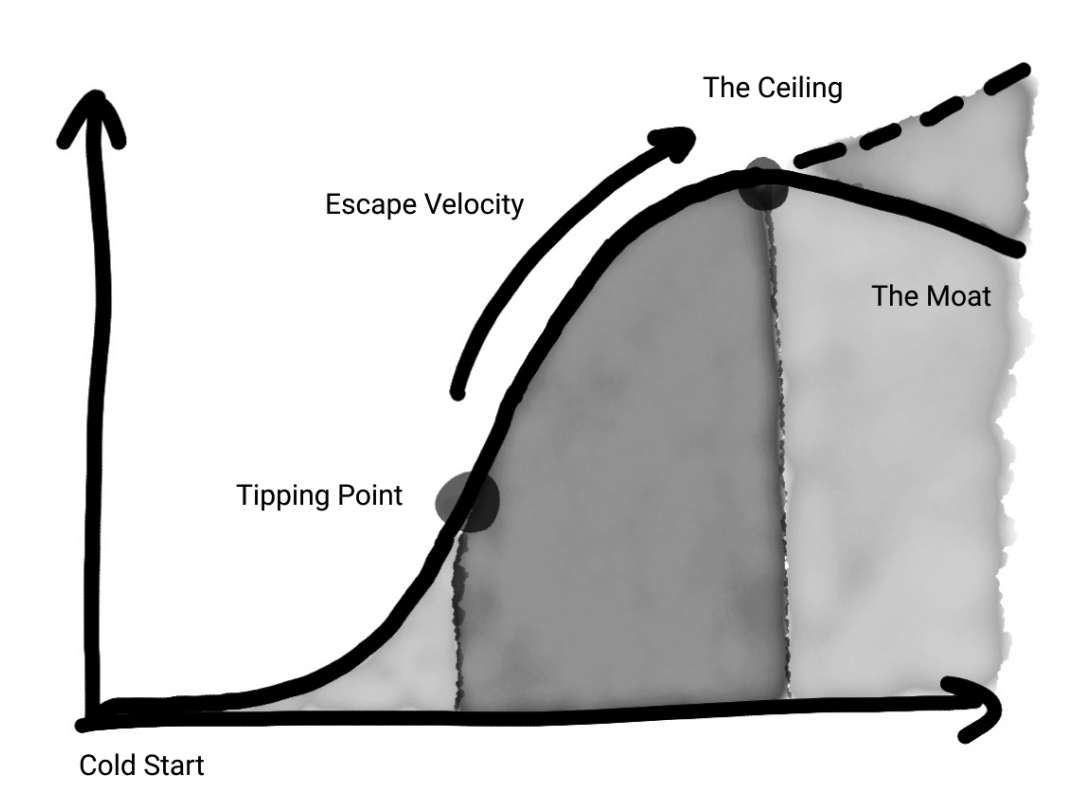the most powerful force in startups: network effects
network effects are the most powerful force in startups. they help small companies grow fast and big companies to retain users
they're the holy grail of the startup world (especially in competitive markets)
i helped grow new products at uber eats and airbnb and have studied them extensively
here's the details on how to leverage them for your startup 👇
network effects and why they matter
network effects are a phenomenon where the product or service becomes more useful or valuable to each user as additional users use it.
some examples:
uber -> more drivers = shorter wait times
slack -> more team members = more valuable archive of conversations
airbnb -> more hosts = more options for travelers
not all products experience network effects. for example, your experience using a personal todo list app does not get better when someone else starts using it
but for the ones that do, network effects provide both the best defense against competition and the strongest way to disrupt existing products in the market
the 5 stages of network effects
to fully harness network effects, a startup must go through 5 stages:
the cold start problem
the tipping point
escape velocity
hitting the ceiling
the moat
a16z general partner andrew chen first identified them in his book the cold start problem. here's how each stage works:

the cold start problem
new networks must first solve the chicken-and-egg problem. how do you get the first users to join a network, when no network exists yet?
to understand this, you have to first understand the concept of an atomic network
an atomic network is the smallest self-sustaining version of a network using the product that can possibly exist. for example, slack famously identified that a team would use slack if it had 3 or more people (not less)
additionally, each network has a type of user that is harder to attract but essential for a network to survive. for example:
facebook's atomic network was a college. the hard type of user was social connectors on campus
uber's atomic network was a city. the hard type of user was drivers
slack's atomic network was a team. the hard type of user was managers
lenny rachitsky wrote a great post about how some of the biggest consumer apps like tiktok, uber, and spotify got their first 1,000 users onto the platform. not all of the products he investigated leverage network effects — see if you can identify which ones do and don't
the tipping point
the counterintuitive lesson about network growth is that it doesn't happen from a single atomic network expanding
instead, a startup should craft a strategy to build as many atomic networks as possible, as quickly as possible (while not sacrificing user experience)
there are 2 common strategies to do this:
make the network invite only. facebook, gmail, linkedin and clubhouse all did this in the early days. this strategy drives hype / fomo and tends to provide a better experience for early adopters
build a tool users want first. instagram first built a tool for editing photos. then it rapidly added social features to become a massive network. chris dixon coined this "come for the tool, stay for the network"
escape velocity
once you have a strategy to build atomic networks at scale, your focus needs to shift to sustaining growth. as paul graham says, "everything else we associate with startups follows growth"
sustained growth comes by building out 3 things:
acquisition -> leverage your network to grow it. dropbox famously developed a referral program that helped them grow 3900%
engagement -> increase the number, types, and depth of user interactions in your network. an easy example here is adding recommendation features
economics -> pursue additional monetization opportunities (i.e. pricing tiers) and improve your unit economics (i.e. efficiency gains)
if you can nail all three of these while balancing all the other challenges a startup comes across, you have a shot at becoming a unicorn
hitting the ceiling
no matter how fast you're initially growing, though, at some point growth will slow down. common reasons for hitting a ceiling are:
market saturation with your target persona
degradation of marketing channels (aka the law of shitty clickthroughs)
increased churn
lower quality engagement on the platform (typically due to trolling and/or fraud)
startups can solve this by either creating new products (like amazon with AWS) or through acquisitions (like facebook buying instagram and whatsapp)
the moat
even if you do well to break through the ceiling, any mature network will need to fend off competition
if you choose not to acquire an upstart, an incumbent can successfully fend them off by either:
improving unit economics / monetization
"fast-following" their features (like instagram launching reels and stories after tiktok and snapchat gained traction)
but, even then, upstarts can succeed by picking off niche segments and building their own atomic networks. the fact is that a mature network won't be able to solve every type of user perfectly, or better than a product specifically targeted to them
with that said, network effects are incredibly sticky — it's hard to leave a social network if all of your friends are on it
additional resources
venture fund NFX created an incredible video-based course on network effects
sahil bloom posted a great thread on network effects last year
erik torenberg also has another great thread on network effects


